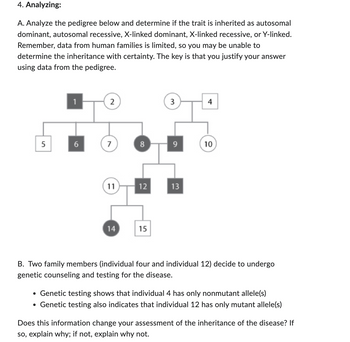
Human Anatomy & Physiology (11th Edition)
11th Edition
ISBN: 9780134580999
Author: Elaine N. Marieb, Katja N. Hoehn
Publisher: PEARSON
expand_more
expand_more
format_list_bulleted
Concept explainers
Topic Video
Question

Transcribed Image Text:4. Analyzing:
A. Analyze the pedigree below and determine if the trait is inherited as autosomal
dominant, autosomal recessive, X-linked dominant, X-linked recessive, or Y-linked.
Remember, data from human families is limited, so you may be unable to
determine the inheritance with certainty. The key is that you justify your answer
using data from the pedigree.
5
6
2
7
11
14
8
12
15
9
13
4
10
B. Two family members (individual four and individual 12) decide to undergo
genetic counseling and testing for the disease.
• Genetic testing shows that individual 4 has only nonmutant allele(s)
• Genetic testing also indicates that individual 12 has only mutant allele(s)
Does this information change your assessment of the inheritance of the disease? If
so, explain why; if not, explain why not.
Expert Solution
This question has been solved!
Explore an expertly crafted, step-by-step solution for a thorough understanding of key concepts.
This is a popular solution
Trending nowThis is a popular solution!
Step by stepSolved in 3 steps

Knowledge Booster
Learn more about
Need a deep-dive on the concept behind this application? Look no further. Learn more about this topic, biology and related others by exploring similar questions and additional content below.Similar questions
- . The following pedigree is for a dominant phenotype governed by an autosomal allele. What does this pedigreesuggest about the phenotype, and what can you deduceabout the genotype of individual A?arrow_forwardOne family is shown in both pedigrees below. Each pedigree focuses on a different monogenic, fully penetrant phenotype. Shaded individuals affected by Phenotype 1: 3 Shaded individuals affected by Phenotype 2: a. Phenotype 1: Which modes of inheritance can be ruled out, base don't this pedigree? For each mode of inheritance listed below, either state that it is not ruled out, or describe a detail of the pedigree that allows you to rule it out. Autosomal recessive Autosomal dominant X-linked recessive X-linked dominant Y-linked b. Phenotype 2: Which modes of inheritance can be ruled out, base don't this pedigree? For each mode of inheritance listed below, either state that it is not ruled out, or describe a detail of the pedigree that allows you to rule it out. Autosomal recessive Autosomal dominant X-linked recessive X-linked dominantarrow_forwardAssumptions: . If the parent expresses the trait, they are homozygous dominant If the child/children express the trait but the parents do not, the parents are heterozygous. Traits selected: Brown Hair/Eyes And Widows Peak Write the Letters you will be using n the Punnet square for each trait: _Ww Bb_and_ww Bb_ Father Genotype: WW Bb Mother Genotype: ww Bb Parent Gametes possible gametes: possible gametes: Do you have the phenotype of either of the traits in the cross? If you do, which one? Are there any other offspring with either trait? Which trait? Which phenotypic probability did you fall into? Which phenotypic probability did other offspring fall into? Iarrow_forward
arrow_back_ios
arrow_forward_ios
Recommended textbooks for you
 Human Anatomy & Physiology (11th Edition)BiologyISBN:9780134580999Author:Elaine N. Marieb, Katja N. HoehnPublisher:PEARSON
Human Anatomy & Physiology (11th Edition)BiologyISBN:9780134580999Author:Elaine N. Marieb, Katja N. HoehnPublisher:PEARSON Biology 2eBiologyISBN:9781947172517Author:Matthew Douglas, Jung Choi, Mary Ann ClarkPublisher:OpenStax
Biology 2eBiologyISBN:9781947172517Author:Matthew Douglas, Jung Choi, Mary Ann ClarkPublisher:OpenStax Anatomy & PhysiologyBiologyISBN:9781259398629Author:McKinley, Michael P., O'loughlin, Valerie Dean, Bidle, Theresa StouterPublisher:Mcgraw Hill Education,
Anatomy & PhysiologyBiologyISBN:9781259398629Author:McKinley, Michael P., O'loughlin, Valerie Dean, Bidle, Theresa StouterPublisher:Mcgraw Hill Education, Molecular Biology of the Cell (Sixth Edition)BiologyISBN:9780815344322Author:Bruce Alberts, Alexander D. Johnson, Julian Lewis, David Morgan, Martin Raff, Keith Roberts, Peter WalterPublisher:W. W. Norton & Company
Molecular Biology of the Cell (Sixth Edition)BiologyISBN:9780815344322Author:Bruce Alberts, Alexander D. Johnson, Julian Lewis, David Morgan, Martin Raff, Keith Roberts, Peter WalterPublisher:W. W. Norton & Company Laboratory Manual For Human Anatomy & PhysiologyBiologyISBN:9781260159363Author:Martin, Terry R., Prentice-craver, CynthiaPublisher:McGraw-Hill Publishing Co.
Laboratory Manual For Human Anatomy & PhysiologyBiologyISBN:9781260159363Author:Martin, Terry R., Prentice-craver, CynthiaPublisher:McGraw-Hill Publishing Co. Inquiry Into Life (16th Edition)BiologyISBN:9781260231700Author:Sylvia S. Mader, Michael WindelspechtPublisher:McGraw Hill Education
Inquiry Into Life (16th Edition)BiologyISBN:9781260231700Author:Sylvia S. Mader, Michael WindelspechtPublisher:McGraw Hill Education

Human Anatomy & Physiology (11th Edition)
Biology
ISBN:9780134580999
Author:Elaine N. Marieb, Katja N. Hoehn
Publisher:PEARSON

Biology 2e
Biology
ISBN:9781947172517
Author:Matthew Douglas, Jung Choi, Mary Ann Clark
Publisher:OpenStax

Anatomy & Physiology
Biology
ISBN:9781259398629
Author:McKinley, Michael P., O'loughlin, Valerie Dean, Bidle, Theresa Stouter
Publisher:Mcgraw Hill Education,

Molecular Biology of the Cell (Sixth Edition)
Biology
ISBN:9780815344322
Author:Bruce Alberts, Alexander D. Johnson, Julian Lewis, David Morgan, Martin Raff, Keith Roberts, Peter Walter
Publisher:W. W. Norton & Company

Laboratory Manual For Human Anatomy & Physiology
Biology
ISBN:9781260159363
Author:Martin, Terry R., Prentice-craver, Cynthia
Publisher:McGraw-Hill Publishing Co.

Inquiry Into Life (16th Edition)
Biology
ISBN:9781260231700
Author:Sylvia S. Mader, Michael Windelspecht
Publisher:McGraw Hill Education